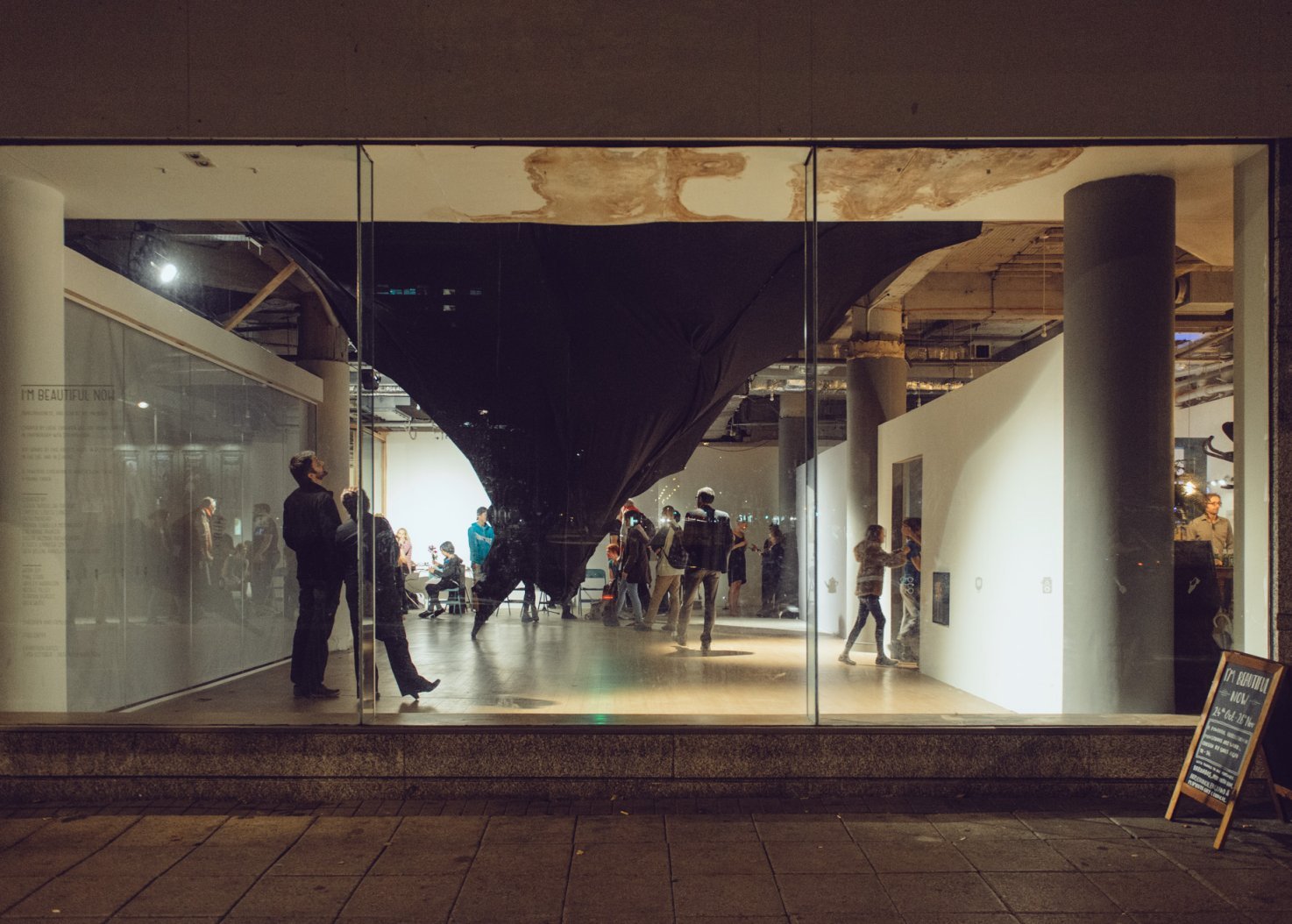
The opening of Radiant in Plymouth
A safe space
Eloise Malone tells how she has transformed a former bank in Plymouth into an art gallery and creative space for vulnerable young people.
It is autumn and I am exhausted. I am watching the trees in the ‘difficult’ end of town turn to gold while I curl up on a Chesterfield sofa in the huge glowing glass bowl which is Radiant, a new cultural laboratory which we recently renovated. It now hosts a bunch of creative micro-organisations. I’m also sipping rose tea from a vintage teacup and I’m contemplating our next show, which has been curated by young carers aged 10 to 14. It explores monstrousness and dread. The nine children we have worked with all live in incredibly difficult circumstances, constantly in fear of losing the few precious moments of happiness they have.
In April we got the keys and a ten-year lease on an abandoned bank. For nine weeks, we pushed our usual workload aside and spent 12 to 16 hours a day smashing down the reinforced carbon fibre and sheet metal strong-room walls, yanking out defunct lighting and data cables, remodelling 12 offices and a cashier’s space into a tea parlour, art gallery, creative hive for independents, and a contemporary art gallery. Our budget for 6,500 square feet of renovation? £5k.
There is a leak in the gallery (which luckily sits next to a beautiful rainbow installation so I think we are getting away with it for now)
A year ago Effervescent was a tiny organisation working out of my spare room. We design and deliver creative transformation programmes for health organisations, schools, museums and children’s charities. When we worked with vulnerable children and young people we did it on other people’s territory, accepting that we would be moved from room to room, or building to building, because we always worked on other people’s terms. Companies often supported us with free space, but at the cost of consistency. The difficulty was that we work with some of the most vulnerable and traumatised children around. Our creative processes are based in psychology, playwork and neuromarketing practices. Every time we moved a group, we had to re-establish the conditions that make the creative space safe. We were undermining our own work because of our reliance on other venues.
So we needed a safe space. But we had almost no money at all: we were a project-funded organisation with a turnover of less than £100k, and no reserves. By chance, we were on the verge of negotiating a three-year contract with Plymouth University when we were suddenly offered the keys to the bank. The university contract gave us the credibility – and match-funding – to apply for additional Arts Council England grant funding. This was to develop an 18-month socially engaged curating project, where we trial methodologies to take gallery education from an added-on element into the core programming of a contemporary art gallery. We could not apply for capital redevelopment funding because none was on offer at the time. So, with the relative safety of 18 months of revenue funding, we cashflowed unavoidable costs and begged, bartered and appealed for community help to transform the bank. We have about 70 people and companies named on our wall of heroes – the people who made this happen. Some we barely knew when we began, but the power of social media meant that local people came and helped.
We have an initial two-year peppercorn phase, followed by a five-year period with escalating rent up to market rates in 2021. That was a hard negotiation, but it has given us two years’ grace to find a model that can cover the costs.
So, we have had to learn to run a vintage tearoom overnight. Luckily, we hired a chef who has quickly established a brilliant reputation, so in January we will be expanding our kitchen (built by plumbing apprentices) and our tearoom into a bistro. That will ensure we bring audiences to the gallery after dark and generate revenue to pay future rent. We have also become the place of choice for local events. Tonight we have a political party holding a meeting and tomorrow night we have a bunch of academics holding an open event on neuroscience and creative process.
There is a leak in the gallery (which luckily sits next to a beautiful rainbow installation so I think we are getting away with it for now) and the toilet floors are ugly. The air conditioning is a complete mystery with a panel of blinking controls the size of a door and no instructions. But among all that, with the tea and the beautiful view of the trees, I’m thinking of one of the young curators’ comments: “This project saved my life.”
Our new dedicated studio has improved our work with children immensely. This is what regeneration is all about. It’s not the building, although that has been the fulcrum for change. It’s about new possibilities, new ways of working and new life paths that just opened up.
Eloise Malone is the Director of Effervescent, Radiant and RumpusCosy.
www.eff.org.uk
www.rumpuscosy.co.uk
Join the Discussion
You must be logged in to post a comment.